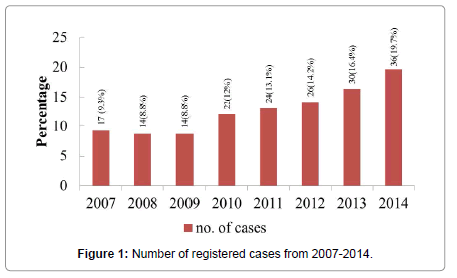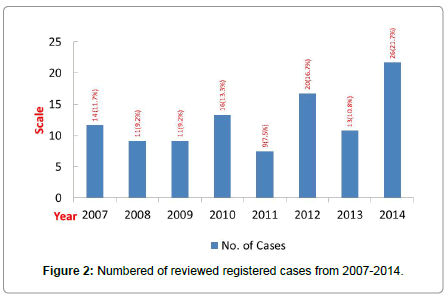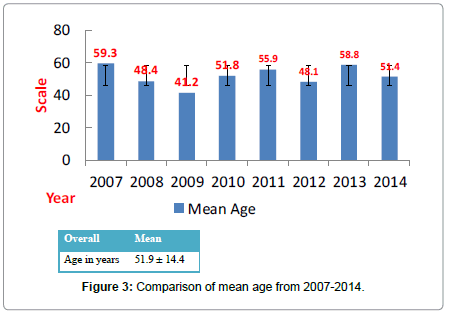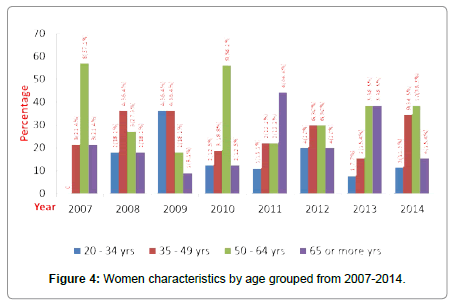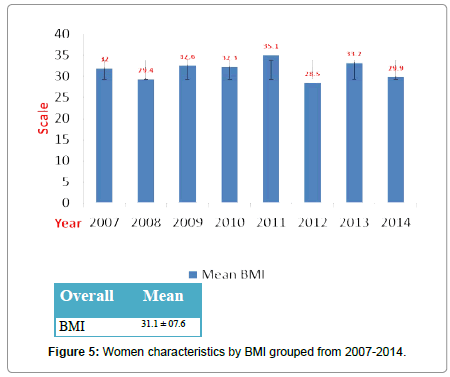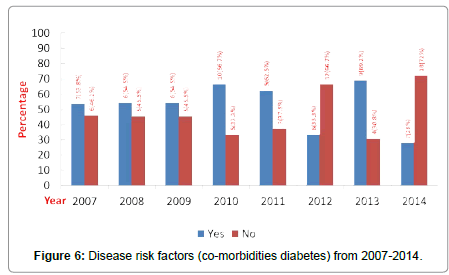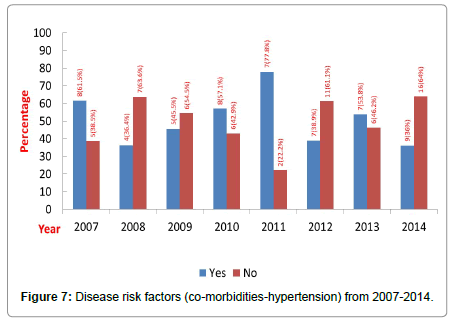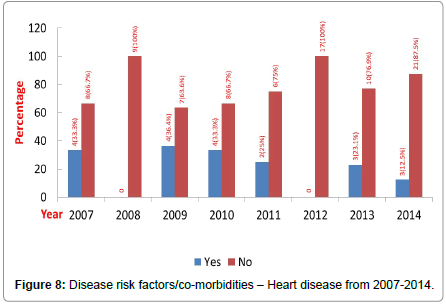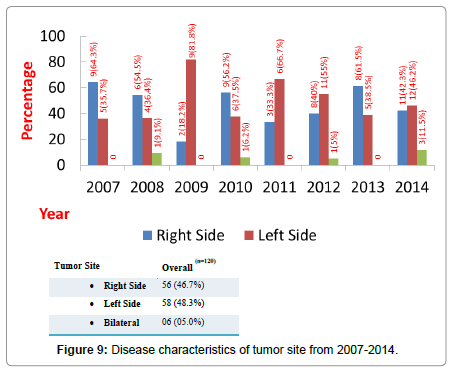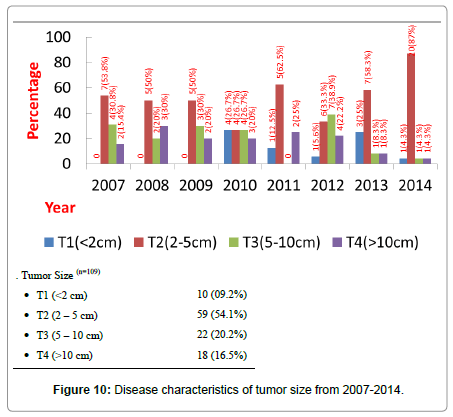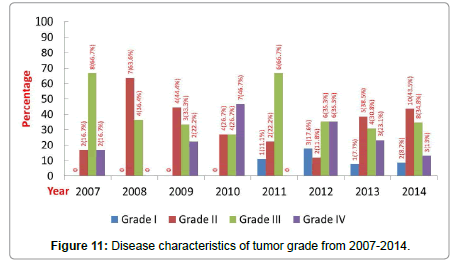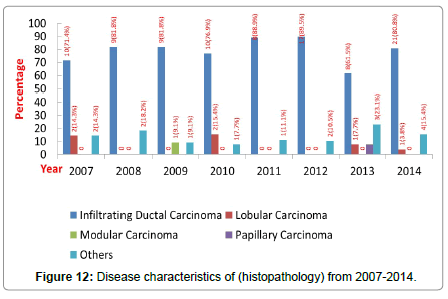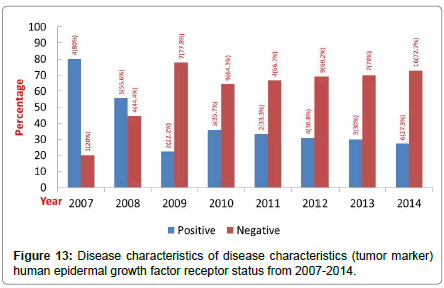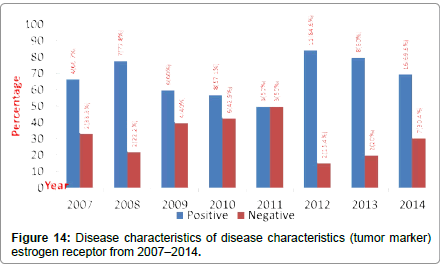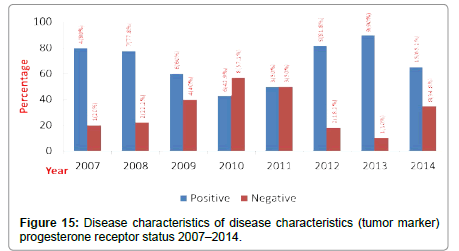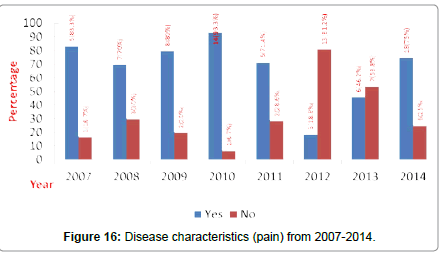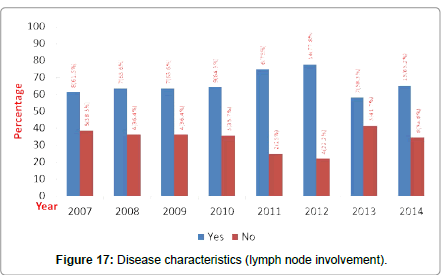Research Article Open Access
Retrospective Study Assessing Breast Cancer Occurrence and its Risk Factors among Females at Al Ahsa
Salwa Hassanein1,2*, Eman Gaber Hassan3,4, Hani Mustafa5, Khawlah Mohammed A Alnaim SN6 and Nashwa Mohammed Al Dossari SN611Department of Community Health Nursing, Cairo University, Cairo City, Egypt
22Department of Community Health Nursing, College of Nursing, King Saud Bin Abdulaziz University for Health Sciences, Saudi Arabia
33Department of Medical Surgical Nursing, Cairo University, Cairo City, Egypt
44Medical surgical Department, College of Nursing/ King Saud Bin Abdulaziz University for Health Sciences, Saudi Arabia
5Department of Medicine, King Abdulaziz Hospital, Al Ahsa, Saudi Arabia
6King Saud Bin Abdulaziz University for Health Sciences, King Abdulaziz Hospital, Al Ahsa, Kingdom of Saudi Arabia
- *Corresponding Author:
- Salwa Hassanein, Ph.D.
Department of Community Health Nursing
Cairo University, Cairo City, Egypt
Department of Community Health Nursing
College of Nursing, King Saud Bin Abdulaziz University for Health Sciences
Saudi Arabia
Tel: 96631429281
Email: salwa.hassanein@yahoo.com
Received date: July 18, 2017; Accepted date: August 07, 2017; Published date: August 31, 2017
Citation: Hassanein S, Hassan EG, Mustafa H, Alnaim SNKMA, Al Dossari SNNM (2017) Retrospective Study Assessing Breast Cancer Occurrence and its Risk Factors among Females at Al Ahsa. J Comm Pub Health Nursing 3:182. doi:10.4172/2471-9846.1000182
Copyright: © 2017 Hassanein S, et al. This is an open-access article distributed under the terms of the Creative Commons Attribution License, which permits unrestricted use, distribution, and reproduction in any medium, provided the original author and source are credited.
Visit for more related articles at Journal of Community & Public Health Nursing
Abstract
Background: Knowing incidence for, breast cancer, co-morbidities, diagnosis and treatment methods given a strategic approach for community awareness and rapid management.
Methods: Retrospective cross-sectional descriptive design was utilized. Total of 183 confirmed breast cancer female patients from 2007-2014 were included but the available reviewed cases were 120. Females with any other type of cancer and any breast cancer (BC) case before 2007 were excluded. IRB approvals have been obtained.
Results: Overall result showed that age of Breast cancer female patients ranged from 40-60 with mean (51.9 ± 14.4). The overall mean of Body Mass Index was (31.1 ± 07.6). The most common comorbidities associated with Breast Cancer females were diabetes, hypertension and heart disease (49.1%; 48.2% and 18.9%). Most Breast Cancer cases were diagnosed with infiltrating ductal carcinoma (79.3%). 48% of the discovered tumor was dominating in the left side of the breast (48.3%). 54.1% of BC females were diagnosed with a tumor size of 2-5cm (T2). 39.4% of BC cases were diagnosed as grade III. Most of the cases (80%) in 2007 were positive human epidermal growth factor receptor 2 (HER2) but it decreased to 27.3% positive cases in 2014. The disease manifestations were a mass in the breast -lump (98.2%), pain (98.2%) and lymph node involvement (66.4%).The first line of treatment used for those patients included mastectomy (79.6%), chemotherapy (67.9%), radiation (34.0%) and hormonal (15.0%).
Conclusion: Current study support and validate the scientific body of knowledge about BC in Saudi Arabia. Each year, the incidence rates increase specially for age above 50. According to Body Mass Index values, there were indications that the cases were obese. Diabetes, hypertension, and heart disease were the common co-morbidities among females with Breast Cancer. Cases of BC were managed by more than one approach such as surgery, chemotherapy, radiation, and hormonal treatment.
Keywords
Breast cancer; Risk factors.
Introduction
Worldwide the second prominent reason of death is Breast cancer (BC). The American Cancer Society (2015) has reported that 1.3 million American females had breast cancer annually [1]. In 2010, World Health Organization reported that BC was the second most common cause of death for females in Kingdom of Saudi Arabia (KSA) [2-4]. Given the fact that the population will be both growing in number as well as aging over the coming years in the KSA, it is anticipated that the occurrence of breast cancer will also be increased [5]. Most often, BC is detected in an earlier age among Arab women, and it is estimated that more than one million new cases of BC are diagnosed annually [6]. It is expected that rates of BC could increase by 50% (1.5 million) new cases per year by the year 2020 [6]. Additionally, in 2007 WHO estimated an overall 26.6 BC cases per 100,000 for the period from 2012 to 2016 among Saudi females [6]. Generally speaking, the frequency rate of BC is higher among elder females aged 50 years and above. However, the age group most influenced by BC in KSA are females more youthful younger than 50 years old.
In relation to BC characteristics, the most common BC symptoms that may appear are having a lump, pain, swelling in or around the breast or armpit, skin thickening or redness, nipple changes or discharges, warmth and itching. The best predictor of the prognosis for BC depends on the histological grade that includes the morphological assessment of tumor biological characteristics [7,8]. In Riyadh, a study that took place between 1980 and 1990 reported that in 58% of cases the mass was greater than 10 cm, and there were no axillary lymph nodes or metastases found during examination [9]. Another study in the same period (1975 to 1991) reported that 64% of BC cases were diagnosed in advanced or metastatic stages (III & IV) [10]. A recent study in Riyadh reviewed cases from 2001 to 2010, and they found that 35.8% of BC cases among were malignant, and the majority of cases, the cancers were infiltrating ductal carcinoma [11]. Another study in Jeddah reported that the second-most common breast lesion was ductal carcinoma, after benign fibroadenoma [12]. Congruent with this finding, another study in Jeddah (from 1985 to 2002) stated a high incidence of benign breast lesions, with 85.3% being non-proliferative, 9.3% being proliferative, and 0.5% being hyperplasia [13]. In addition, a study in Al-Jouf reported that a benign lesion is the most frequent histopathological finding [14].
In an eastern province, a study between 1985 and 1995 found that approximately half of the cases reviewed (53%) were detected in the early stages (I & II) although the rest were in advanced stages (III & IV) [15]. Related to the same region, a study in Dammam from 1997 to 2007 mentioned that 31.08 % of cases were diagnosed with malignant BC [16]. A recent study in Al Khobar reported that more women were diagnosed with BC in advanced stages as compared to women in other countries such as the United States [16]. Finally in a histopathology record review in Al Ahsa between 2001 and 2007, they found that a benign lesion was common (60.1%) in relation to 21.4% malignancy and 18.5% inflammatory lesion [17].
The management of BC be determined based on the stage and characteristics of the cancer cells. The treatment may include surgical intervention and/or radiation therapy, which are considered to be local therapies, or systemic therapy, such as chemotherapy or hormonal or targeted therapy [1]. For those who have no cancer detectable or who in the early stages, without confirmation of primary spread of cancer cells to the surrounding tissue, the treatment may include both systemic therapy and targeted therapy in addition to radiation (as adjuvant therapy). Some cases are given hormonal therapy before surgical intervention (neoadjuvant therapy). The aim is to decrease tumor size, which allows for less extensive surgical intervention and can decrease the chances of the cancer recurring later [18].
The aim of surgical interventions is to remove the tumor. There are different types of surgery ranging from removing the tumor cells to extensively removing the entire breast with the surrounding tissue, lymph nodes, and chest wall muscles beneath the breast(s) [19]. Chemotherapy is the use of cancer-killing medications which are given either orally or directly to the blood stream (intravenously). It is usually given to patients in cycles with periods of recovery between treatments. Cycles are often 2 to 3 weeks long, resulting in treatment that lasts for several months [1]. Targeted therapy (biological therapy) aims to treat females with BC who have the growth-promoting n (HER2/neu or HER2) on the tumor cells. This type of cancer cell tends to grow and spread aggressively. In these cases, their treatment plan should include drugs specifically targeted to these variations. These drugs can be utilized for both early and late stage breast cancer; in addition, biological therapy can be combined with chemotherapy [19]. Hormone therapy is useful for the BC cases who have positive hormone receptors (either estrogen receptor [ER] or progesterone receptor [PR]. These hormones promote the growth of cancer cells. Hormone therapy therefore aims to reduce the estrogen and progesterone levels to reduce the possibility of cancer cells recurring, and it can be used either before surgery as a neoadjuvant treatment or after therapy as adjuvant therapy [1,20].
Significance of the study
Breast cancer is regularly researched and reported from developed countries and Western nations, however, information on applicable reports from Saudi Arabia showed up either scattered or not brought into the spotlight in Arabian nations. A selective literature review was done with the intention of providing information to enrich knowledge for the organization of screening, treatment, and preventative approaches for BC in KSA [21]. Other studies [16, 22-26] considered the risk factors of BC. Early identification of breast cancer is crucial and needs special attention. There is a need to review the incidence of BC retrospectively in KSA to explore the magnitude of the disease and how it changes over time. So the study aimed to: assess Breast Cancer occurrence among female patients at King Abdul Aziz Hospital -Al Ahsa. The objectives as follows:
1. Assess the demographic pattern including: age, nationality, and body mass index (BMI)
2. Assess the pattern of BC risk factors including: Co-morbidities;
3. Assess the pattern of BC characteristics, including: Histopathology , tumor site, tumor size, tumor grade, HER2/ neu (Human Epidermal Growth Factor Receptor) status, estrogen and progesterone receptor status, Signs and Symptoms
4. Assess the pattern of BC management, including: Diagnostic procedure, type of treatment, chemotherapy sessions, and duration of treatment
5. Assess the pattern of BC treatment complications
Materials and Methods
Study area/Setting
This study has been conducted by using Health information system and Electronic data base at King Abdul-Aziz Hospital - Al-Ahsa and the documented registry system of KHA-Al AHSA.
Study subjects
Inclusion criteria: All women diagnosed with BC (at any stage of cancer at diagnosis) who are in the registry system at King Abdulaziz Hospital in Al-Ahsa covering the calendar period from 2007 through 2014 included in the study.
Exclusion criteria: Females with any other type of cancer and any BC case before 2007 were excluded
Study design
Retrospective descriptive design has been utilized to achieve the aim of the study
Sample
In order to obtain a representative sample for a particular target population, convenience sampling was utilized that usually used in exploratory research when we are interested in getting an inexpensive ‘approximation of the truth’. Total 183 confirmed breast cancer female patients from 2007-2014 included in the study (Flowchart 1).
Data collection procedures
The Institutional Review Board (IRB) approvals have been obtained from King Abdullah International Medical Research Center (KAIMRC)-Eastern Region. Hard copies of patient charts ordered and reviewed for the proposed variables to answer the research questions, and QuadraMed’s Electronic database queried because it offers integrated, workflow-driven answers for empowering the clinicians to arrange and accomplish patient care activities, access patients data and report the care delivered. The computer system utilized to review and extract the proposed variables. To maintain stability, integrity, clarity and consistency for all data mining, the researcheres use all of the King Abdulaziz Hospital’s data resources (HIS)/Electronic Database. To eliminate any discrepancies and to ensure the validity of the data, both the hard copies and the electronic database were reviewed. To ensure the reliability and validity of existing data quality, convenience sample of ten patients ordered to identify the variables to be measured which represent the conceptual constructs that defined by the study which are available through the NGHA electronic database and to check the time duration required to collect the data as well. Furthermore, the 10 records checked by two different data collectors and percent of agreement calculated.
Instruments
The following instruments include only the actual variables that were available in the electronic database and patient chart. : Demographics, women characteristics, breast cancer risk factors, disease characteristics, lifestyle, disease management, and any complications.
A. Women’s characteristics:
a. Age: is defined as the chronological age at the time the patient was first diagnosed with breast cancer
b. Nationality: measured in terms of whether the patient is Saudi or Non Saudi.
c. BMI: body mass index calculated based on the current body weight in Kg and height in cm. BMI will be calculated at the time of diagnosis BMI = Weight (kg)/[Height (m)]2
d. Marital status will be coded as (1) single (2) married (3) divorced (4) widowed
B. Breast cancer risk factors:.
a. Comorbidity will be coded as (1) Diabetes, (2) HTN,(3) Heart disease, (4) Lung disease, or (5) Others
C. Disease characteristics:
a. Tumor site coded as (1) right side, (2) left side, (3) bilateral, or (4) unknown
b. Tumor size coded as (1) T1 (<2 cm), (2) T2 ( 2-5 cm), (3) T3 ( 5-10 cm), (4) T4 (>10 cm), or (5) Unknown
c. Tumor grade coded as (1) Grade I, (2) Grade II, (3) Grade III, (4) Grade IV, or (5) Unknown
d. Histopathology coded as (1) infiltrating ductal carcinoma, (2) lobular carcinoma, (3) modular carcinoma, (4) papillary carcinoma, or (5) others
e. Number of lymph nodes coded as (1) None (0), (2) 1 – 3, (3) 4 – 9, (4) 10 or more, or (5) Unknown
f. HER2/neu status coded as (1) Positive (IHC 3+), (2) Negative, or (3) Unknown
g. Estrogen Receptor status coded as (1) Positive, (2) Negative, or (3) Unknown
h. Progesterone Receptor status coded as (1) Positive, (2) Negative, or (3) Unknown
D. Management of the disease:
i. Mammogram screening coded as (1) Yes or (2) No
j. Type of treatment will be coded as (1) Surgery, (2) Radiation Therapy, (3) Hormonal Therapy, (4) Chemotherapy or (5) Other.............
k. Number of chemotherapy Session: …………………….
l. Duration of treatment will be coded as (1)<5 years, (2) 3-5 years, (3) 5-9 years or (4)>10 years.
m. Your information and knowledge of breast cancer came from will be coded as from (1) Physician, (2) Nurse, (3) Cancer Educator, (4) Newspaper, (5) Books, (6) Internet, (7) Friends, (8) Family or (9) Other
E. Treatment complication:
1. Pain 2. Fatigue 3. Infection 4. Difficulty breathing 5. Nausea 6. Weight loss 7. Diarrhea 8. Constipation 9. Emotional distress 10. Depression 11. Insomnia 12. Sexual problems 13. Others
Results
The results revealed that numbers of breast cancer (BC) females who were documented in the registry system of King Abdulaziz Hospital (KAH) from 2007-2014 are increasing per year (Figure 1). In 2007, 17 of the females were confirmed as BC cases and the number of cases increased to be 36 in 2014. The actually reviewed number of cases were 120 cases (Figure 2). Despite the register from 2007 to 2014 were 183 but we have 25 cases of death and 25 cases were newly cases referred to Imam Abdulrahman hospital in Dammam and 13 cases were excluded because there are no any available data. The result showed that the age of our female patients from 2007-2014 (Figure 3 &4) ranged from 40-60 with overall mean (51.9 ± 14.4). The Body Mass Index (BMI) showed a value of overall mean of (31.1 ± 07.6) in (Figure 5).
BC risk factors
The results revealed that the most common comorbidities associated with BC females were diabetes (DM), hypertension (HTN) and heart disease (Figures 6-8). It is clear that most of the confirmed BC cases in the defined period were diagnosed with infiltrating ductal carcinoma (Figure 12). Around 48% of the discovered tumor were dominated in the left side of breast (Figure 9) followed by the right side while only 05.0% of cases were bilateral. It has been shown that most of BC females came with tumor size between 2-5cm (T2) (Figure10). Most of our BC cases came with grade III which is alarming (Figure11).
Regarding tumor markers, almost of the cases (80%) in 2007 were positive HER2 but it decreased to 27.3% positive cases in 2014. While almost of BC females were positive Estrogen Receptor (ER) from 2007- 2014. Similarly, Progesterone Receptor (PR) was positive in most of the confirmed BC cases all over the revised period (Figures 13-15).The most reported disease manifestation were mass in the breast (lump), pain and lymph node involvement (Figure 16,17).
BC management
It was found in the result that the trends of diagnosing BC in KAH were mammogram screening, ultrasound and biopsy (Table 1). Surgery, chemotherapy, radiation therapy and hormonal therapy are the common types of treatment, which were used in KAH (Table 2). It is appearing that the patients were treated by more than one way of treatment. In relation between tumor grade and type of treatment, most of the patients who had grade II and III were managed by surgery and chemotherapy, while patients who came with grade IV were treated by chemotherapy and radiation therapy. The results showed that the number of chemotherapy sessions from 2007-2014 had mean of 7 sessions (Table 2). Regarding duration of the treatment most of female cases were treated in <3 years (Table 2).
| Year | |||||||||
|---|---|---|---|---|---|---|---|---|---|
| Factors | Overall | 2007(n=14) | 2008(n=11) | 2009(n=11) | 2010(n=16) | 2011(n=9) | 2012(n=20) | 2013(n=13) | 2014(n=26) |
| Diagnostic procedure Q49. Mammogram screening (n=110) |
|||||||||
| • Yes | 94 (85.5%) | 06 (54.5%) | 08 (80.0%) | 07 (63.6%) | 13 (86.7%) | 08 (100%) | 17 (89.5%) | 12 (100%) | 23 (95.8%) |
| • No | 16 (14.5%) | 05 (45.5%) | 02 (20.0%) | 04 (36.4%) | 02 (13.3%) | 0 | 02 (10.5%) | 0 | 01 (04.2%) |
| Q50. Biopsy(n=110) | |||||||||
| • Yes | 98 (89.1%) | 06 (50.0%) | 09 (90.0%) | 09 (81.8%) | 13 (86.7%) | 07 (100%) | 19 (100%) | 12 (100%) | 23 (95.8%) |
| • No | 12 (10.9%) | 06 (50.0%) | 01 (10.0%) | 02 (18.2%) | 02 (13.3%) | 0 | 0 | 0 | 01 (04.2%) |
| Q51. Ultrasound(n=110) | |||||||||
| • Yes | 87 (79.1%) | 04 (33.3%) | 04 (40.0%) | 07 (63.6%) | 11 (73.3%) | 07 (100%) | 18 (94.7%) | 12 (100%) | 24 (100%) |
| • No | 23 (20.9%) | 08 (66.7%) | 06 (60.0%) | 04 (36.4%) | 04 (26.7%) | 0 | 01 (05.3%) | 0 | 0 |
| Q52. Bone Scan(n=108) | |||||||||
| • Yes | 22 (20.4%) | 0 | 0 | 0 | 02 (13.3%) | 04 (57.1%) | 11 (64.7%) | 0 | 05 (20.8%) |
| • No | 86 (79.6%) | 12 (100%) | 10 (100%) | 11 (100%) | 13 (86.7%) | 03 (42.9%) | 06 (35.3%) | 12 (100%) | 19 (79.2%) |
Table 1: Management of the disease.
| Year | |||||||||
|---|---|---|---|---|---|---|---|---|---|
| Factors | Overall | 2007(n=14) | 2008(n=11) | 2009(n=11) | 2010(n=16) | 2011(n=9) | 2012(n=20) | 2013(n=13) | 2014(n=26) |
| Q53. Surgery (n=113) | |||||||||
| Yes | 90 (79.6%) | 08 (66.7%) | 10 (90.9%) | 08 (80.0%) | 10 (62.5%) | 08 (88.9%) | 17 (94.4%) | 11 (84.6%) | 18 (75.0%) |
| No | 23 (20.4%) | 04 (33.3%) | 01 (09.1%) | 02 (20.0%) | 06 (37.5%) | 01 (11.1%) | 01 (05.6%) | 02 (15.4%) | 06 (25.0%) |
| Q54. Radiation therapy (n=106) | |||||||||
| Yes | 36 (34.0%) | 04 (33.3%) | 04 (36.4%) | 01 (10.0%) | 12 (80.0%) | 04 (44.4%) | 04 (28.6%) | 03 (23.1%) | 04 (18.2%) |
| No | 70 (66.0%) | 08 (66.7%) | 07 (63.6%) | 09 (90.0%) | 03 (20.0%) | 05 (55.6%) | 10 (71.4%) | 10 (76.9%) | 18 (81.8%) |
| Q55. Hormonal therapy (n=100) | |||||||||
| Yes | 15 (15.0%) | 01 (08.3%) | 02 (18.2%) | 02 (20.0%) | 04 (26.7%) | 01 (20.0%) | 01 (08.3%) | 03 (23.1%) | 01 (04.5%) |
| No | 85 (85.0%) | 11 (91.7%) | 09 (81.8%) | 08 (80.0%) | 11 (73.3%) | 04 (80.0%) | 11 (91.7%) | 10 (76.9%) | 21 (95.5%) |
| Q56. Chemotherapy (n=109) | |||||||||
| Yes | 74 (67.9%) | 07 (63.6%) | 07 (63.6%) | 08 (80.0%) | 13 (86.7%) | 04 (57.1%) | 12 (66.7%) | 09 (69.2%) | 14 (58.3%) |
| No | 35 (32.1%) | 04 (36.4%) | 04 (36.4%) | 02 (20.0%) | 02 (13.3%) | 03 (42.9%) | 06 (33.3%) | 04 (30.8%) | 10 (41.7%) |
| Number of session (n=57) | 07 (4-31) | 8 (6-12) | 6 (4-8) | 8 (4-10) | 8 (4-21) | 8 (8-31) | 4 (4-11) | 6 (4-8) | 8 (4-18) |
| Mean �?± Standard Deviation | 8.0 �?± 4.9 | 8.5 �?± 2.5 | 5.8 �?± 1.8 | 7.2 �?± 3.0 | 9.7 �?± 5.9 | 13.7 �?± 11.5 | 5.4 �?± 2.3 | 6.2 �?± 1.6 | 8.9 �?± 4.7 |
| Q57. Duration of treatment (n=71) | |||||||||
| <3 years | 42 (59.2%) | 03 (25.0%) | 06 (75.0%) | 01 (25.0%) | 05 (50.0%) | 04 (66.7%) | 05 (55.6%) | 04 (57.1%) | 14 (93.3%) |
| 3-5 years | 18 (25.4%) | 05 (41.7%) | 01 (12.5%) | 01 (25.0%) | 03 (30.0%) | 01 (16.7%) | 03 (33.3%) | 03 (42.9%) | 01 (06.7%) |
| >5-9 years | 11 (15.5%) | 04 (33.3%) | 01 (12.5%) | 02 (50.0%) | 02 (20.0%) | 01 (16.7%) | 01 (11.1%) | 0 | 0 |
*Results are expressed as number (%).
Table 2: Type of treatment.
Complications during the treatment
The most significant treatment complications among BC patients were pain, fatigue, emotional distress, weight loss, nausea, insomnia and depression (Table 3).
| Year | |||||||||
|---|---|---|---|---|---|---|---|---|---|
| Factors | �? �? Overall |
2007 (n=14) | 2008 (n=11) | 2009 (n=11) | 2010 (n=16) | 2011 (n=09) | 2012 (n=20) | 2013 (n=13) | 2014 (n=26) |
| Q72. Emotional Distress (n=82) | |||||||||
| • Yes | 62 (75.6%) | 09 (69.2%) | 09 (90.0%) | 07 (77.8%) | 12 (92.3%) | 03 (75.0%) | 05 (50.0%) | 05 (62.5%) | 12 (80.0%) |
| • No | 20 (24.4%) | 04 (30.8%) | 01 (10.0%) | 02 (22.2%) | 01 (07.7%) | 01 (25.0%) | 05 (50.0%) | 03 (37.5%) | 03 (20.0%) |
| Q73. Depression (n=82) | |||||||||
| • Yes | 43 (52.4%) | 06 (46.2%) | 07 (70.0%) | 05 (55.6%) | 05 (38.5%) | 01 (25.0%) | 04 (40.0%) | 04 (50.0%) | 11 (73.3%) |
| • No | 39 (47.6%) | 07 (53.8%) | 03 (30.0%) | 04 (44.4%) | 08 (61.5%) | 03 (75.0%) | 06 (60.0%) | 04 (50.0%) | 04 (26.7%) |
| Q74. Insomnia (n=78) | |||||||||
| • Yes | 43 (55.1%) | 03 (25.0%) | 08 (80.0%) | 07 (87.5%) | 05 (41.7%) | 01 (25.0%) | 04 (44.4%) | 05 (62.5%) | 10 (66.7%) |
| • No | 35 (44.9%) | 09 (75.0%) | 02 (20.0%) | 01 (12.5%) | 07 (58.3%) | 03 (75.0%) | 05 (55.6%) | 03 (37.5%) | 05 (33.3%) |
| Q75. Sexual problem (n=59) | |||||||||
| • Yes | 10 (16.9%) | 0 | 02 (33.3%) | 01 (16.7%) | 03 (33.3%) | 0 | 0 | 01 (20.0%) | 03 (21.4%) |
| • No | 49 (83.1%) | 12 (100%) | 04 (66.7%) | 05 (83.3%) | 06 (66.7%) | 03 (100%) | 04 (100%) | 04 (80.0%) | 11 (78.6%) |
*Results are expressed as number (%).
Table 3: Patients’ treatment complication.
Discussion
The current study supports and validates the scientific body of knowledge about BC in KSA. The incidence rates increase per year [6,27]. Despite the BC incidence is low in KSA in comparison with other developing countries [29] but it remains the first type of cancer among Saudi female [28]. The incidence of BC was increasing proportionally among females from different ages from 10.2% (2000) to 24.3% (2005) [20-27]. This is consistent with our registry number that showed increase BC cases across the years to reach nearly the double of cases from 2007 to 2014 (14 cases to 26 cases). Another author also reported that women with BC increase from 1152 in 2008 to 1473 in 2010 [30]. Furthermore, the Research Center Registry and the King Faisal specialist hospital and stated increase in BC cases in 2011 (Tumour registry annual report, 2012) [31].
Our data revealed that the age of the BC cases were ranged from 40- 60 with mean age. This result is consistent with [32] a study conducted in Riyadh for 867 patients had BC from 1986 to 2002. They compared the features and management outcomes between younger and older age clusters, and the study showed being more youthful (age<or=40) to be an independent hazard element for BC relapse. Another research reviewed the epidemiology of BC cases in eastern province and they found that BC cases were detected at earlier age (<50 years: 57.5%) [16]. Other studies in different region in the kingdom and at different period reported the same range of age. In Riyadh, two-thirds of BC cases were premenopausal [33-34]. As well as result was consistent since the first registry in the eastern province for Saudi women [35] which mentioned that the crude incidence rate (CIR), age-standardized incidence rate (ASR) were 43.6 and 95.5, correspondingly. In another study in eastern region between 1985-1995, they also found that most of the females were pre-menopausal (79%) at age below 50 years [15]. Almost the same mean age were reported in different studies from 2000 to 2015, reviewed seven studies and found the mean age was 44.18 years; another study reported the median age is 48-52 and half of cases is under 50 and the most affected age was range 43-52 [6]; another study mentioned the average age was 48 [30]. However, the average age of the most affected BC cases in USA and Europe countries is higher than in Saudi Arabia, 50 years and older [21,30,36-37]. This may be interpreted in relation to increase BMI or increase incidence of diabetes mellitus in KSA [6].
For the risk factors, the reviewed records showed that the common risk factors among BC females were increase body mass index (BMI) mean of (31.1 ± 07.6), and the most common associated comorbidities among them were diabetes, hypertension, and heart disease. This is consistence with outdated risk factors for developing BC, which are null parity, early menarche, late pregnancy and menopause, increase intake of diet rich in fat [21]. It was been testified in another study that the incidence of comorbidity disease was 15.4% hypertension, 7.1% diabetes, 34% smoking and the elder BC cases had diabetes, hypertension, and cardiac diseases (P<0.001) [38].
In relation to disease characteristics, the reviewed records indicated that almost of BC patients had infiltrating ductal carcinoma with T2 tumour size (2-5 cm). The results congruent with other studies that BC diagnosed in KSA are at an older age with higher stage of tumor compared to western countries [16,21]. In a recent review of breast biopsy in Riyadh between 2001 and 2010, they found that invasive ductal carcinoma was reported among malignant patients from male and the majority of female patient were invasive/infiltrating ductal carcinoma [11]. In the laboratory records review study done at 2001 they reported that ductal carcinoma (80%) and lobular carcinoma (5.5%) were the common finding [12]. In addition, the results showed that almost of them were diagnosed at grade III. These research outcomes were consistent with the two earlier studies, which were done in eastern provinces. The first was between 1985 and 1995, and reported that most of the patients had stage II (44%) and III (30%) while 16% were stage IV [15] consistent with [34] 64% of cases had stages III and IV. The second study was review record in AL Khobar; found that the female with BC were diagnosed in higher stage in contrary to the BC cases in United States who were diagnosed in lower stage [16]. This could be interpreted in relation to insufficient knowledge about Breast self-examination and pre-screening mammography era and low level of education among female in the past in comparison to now. Selective studies were conducted to assess the effect of Breast-Self Examination (BSE) on morbidity and mortality reduction [26]. Nevertheless, even with the increasing number of health campaigns talking about breast cancer early detection, there is still insufficient knowledge among Saudi women. Despite BSE is recognized to be one of the techniques for early discovery for breast cancer. The current study is retrospective study and there is missing data about the BSE. In a study done in Dammam testing knowledge about breast cancer, they mentioned that there is inadequacy in information and beliefs about screening mammography between females with high and low education [39]. Another study in Qassim showed unsatisfactory level of awareness about BC for 300 women majority of them were literate in addition to 70% of them had no idea about BSE [24]. In Riyadh, a study represented high knowledge about breast self-examination (BSE) and mammogram from the participants but moderate knowledge about risk and protective factors. In addition, there is relation between education level and knowledge and practice regarding BSE [40]. In population-based study (1,315 women) at Al Ahsa governorate, the results showed lower rates of mammography (5.1%) [17]. In a survey study in 2013 for about 10,735 participants, 89% of respondent female did not perform the clinical breast exam and 92% never had a mammogram before [41]. They found also that the highest rate of mammography screening was among the women from Al Sharqia, and the incidence of a routine medical check-up was highest among the educated women in the last two years [41]. Selective studies were also done in Saudi Arabia in 2010-2011 about mammographic screening [29,42-43], their results have shown the importance of public awareness of mammographic screening, which helps in early detection and diagnosis of breast cancer.
Our data showed almost of BC cases (80%) were positive (HER2) in 2007 and decreased in 2014 (27.3%). While almost of females were positive to ER and PR during the completely reviewed period. The frequency of HER” and MYC was greater in Saudi than Swiss BC cases and they interpreted that due to genetic difference, different lifestyle and to increased incidence of BC cases diagnosed with higher grade [44,45]. Although different study reported that of all tested specimens, 28.3% were positive HER-2/neu which was matching with literature. The previous studies indicated there is inversely correlation between HER-2/neu and ER [46]. A study between1992 and 1998 indicated that the incidence of ER positive tumour was increased by 20% [47]. In addition they mentioned that there is increase in ER/PR positive tumour among cases between 40-49 years old and 50-59 years olds (from 56% to 62.3%) and (from 63.2% to 67.9%) respectively. literature review proposed that there is a great effect from estrogen and progesterone on BC, where growth of majority of BC were stimulated by estrogen level in addition to the significant role of progesterone in the breast growth and tumorigenesis [21]. In Assir and Abha study, analysed 100 mastectomy specimens and found that the progression of BC is connected with ER, PgR and HER-2/neu expression [48,49].
Surgery, chemotherapy, radiation therapy and hormonal therapy are the common types of treatment used according to records. Reviewed the available American data (SEER database), it was found that the mastectomy rate was the highest (58.2%) [16]. Other research also pointed around half of the elder cases (53.1%) above 50 years treated by chemotherapy in compare to younger group (76.5%) [38]. The current study supported that cases of BC treated with a multidisciplinary approach, merging the efforts of surgery, chemotherapy, and radiation therapy based on the BC stages [37]. This study also backed up by previous literary finding extracted that almost BC cases reported pain, fatigue, and emotional distress as adverse effects of the treatment [37] that is matching with our study.
Conclusion
The reviewed records concluded that KAH registry, the number of BC cases is increasing annually. Women above 50 have higher incidence rates of BC, as well as most of the cases, were diagnosed with grade III. According to BMI values, most of our cases were obese as well as diabetes, hypertension, and heart disease was the common co-morbidities among females with BC. The reported manifestation among cases were cases mass in the breast (lump), pain and lymph node involvement. The first line of treatment were used for those patients including mastectomy, followed by chemotherapy and sometimes radiation. The most significant treatment complications among patients were pain, fatigue, emotional distress, nausea, insomnia, depression, and weight loss. In summary, the retrospective study magnify the valuable data about the incidence, co-morbidity factors, disease characteristics, diagnostic measures, and disease management that is could be guide to implement surveillance program for breast cancer in Saudi Arabia.
Recommendations
The present study recommended that BC specific more awareness campaigns and further resources will be needed to encounter the future increase in BC incidence. Early detection and screening of BC may have a significant role in decreasing the mortality and increasing the survival rate. Further study is recommended to investigate the association between diabetes and hypertension as risk factors for BC. As well as further studies are recommended to enhance the data for the arrangement of screening, managing and precautionary strategies of BC in KSA.
Limitation
This study limitation lies on incomplete data due to nature of the study (retrospective design) including women characteristics (e.g. occupation, level of education, Smoking status), pattern of risk factors (e.g. except for reported diagnosed co-morbidity) and all data related to pattern of life style among female patient including (practice of self-breast exam, increased weight gain, exercise, nutrition, environmental pollution, exposure to environmental and/or chemical pollution, screening by mammogram). Furthermore, the descriptive cross sectional design does not allow to establish causal relationships between variables.
References
- American Cancer Society (2015) How is breast cancer treated?
- Mokdad AH, Jaber S, Aziz MI, AlBuhairan F, AlGhaithi A, et al. (2014) The state of health in the Arab world, 1990-2010: An analysis of the burden of diseases, injuries and risk factors. Lancet 383: 309-320.
- Lozano R, Naghavi M, Foreman K, Lim S, Shibuya K, et al. (2013) Global and regional mortality from 235 causes of death for 20 age groups in 1990 and 2010: A systematic analysis for the Global Burden of Disease Study 2010. Lancet 380: 2095-2128.
- World Health Organization (2013) World health statistics.
- Ibrahim EM, Zeeneldin AA, Sadiq BB, Ezzat AA (2008) The present and the future of breast cancer burden in the Kingdom of Saudi Arabia. Med Oncol 25: 387-393.
- World Health Organization (2013) WHO country cooperation strategy at a glance: Belize.
- Rakha EA, Reis-Filho JS, Baehner F, Dabbs DJ, Decker T, et al. (2010) Breast cancer prognostic classification in the molecular era: The role of histological grade. Breast Cancer Res 12: 207.
- Simpson JF, Gray R, Dressler LG, Cobau CD, Falkson CI, et al. (2000) Prognostic value of histologic grade and proliferative activity in axillary node��?positive breast cancer: Results from the Eastern cooperative oncology group companion study, EST 4189. J Clin Oncol 18:2059-2069.
- Ezzat A, Abdulkareem A, El-Senoussi M, Wierzbicki R, Bazarbashi S, et al. (1994) Malignant cystosarcoma phyllodes: A review of the clinical experience at King Faisal Specialist Hospital and Research Centre. Ann Saudi Med 14:198-200.
- Ezzat AA, Ibrahim EM, Raja MA, Al-Sobhi S, Rostom A, et al. (1999) Locally advanced breast cancer in Saudi Arabia: High frequency of stage III in a young population. Med Oncol 16: 95-103.
- Al-Rikabi A, Husain S (2012) Increasing prevalence of breast cancer among Saudi patients attending a tertiary referral hospital: A retrospective epidemiologic study. Croat Med J 53:239-43.
- Mansoor I (2001) Profile of female breast lesions in Saudi Arabia. Retraction Article.
- Altaf FJ, Abdullah LS, Jamal AA (2004) Frequency of benign and preinvasive breast diseases. Saudi Med J 25: 493-497.
- Chiedozi LC, El-Hag IA, Kollur SM (2003) Breast diseases in the Northern region of Saudi Arabia. Saudi Med J 24: 623-627.
- Ibrahim EM, al-Mulhim FA, al-Amri A, al-Muhanna FA, Ezzat AA, et al. (1998) Breast cancer in the eastern province of Saudi Arabia. Med Oncol 15: 241-247.
- Rudat V, El-Sweilmeen H, Fadel E, Brune-Erber I, Ahmad Nour A, et al. (2012) Age of 40 years or younger is an independent risk factor for locoregional failure in early breast cancer: A single-institutional analysis in Saudi Arabia. J Oncol, pp: 1-10.
- Amin TT, Al Mulhim AR, Al Meqihwi A (2009) Breast cancer knowledge, risk factors and screening among adult Saudi women in a primary health care setting. Asian Pac J Cancer Prev 10:133-138.
- National Comprehensive Cancer Network (NCCN) (2015) NCCN guideline for patients; Stage I and II breast Cancer.
- Cancer Research UK (2015) Types of breast cancer surgery.
- National Cancer Institute (2015) Breast cancer treatment.
- Abdurrahman Al Diab SQ, Khalid AA (2013) Studies on the methods of diagnosis and biomarkers used in early detection of breast cancer in the Kingdom of Saudi Arabia: An overview. World J Med Sci 8: 36-47.
- Abdallah AS, El-Gharabawy RM, Al-Suhaibany HO (2015) Knowledge, attitude and practice about breast cancer among women in Saudi Arabia. Int Arch Med 8: 1-13.
- Iqbal J, Abukhatir M, Shafi AA, Alyahya GM, Alharthi BN (2014) Hormone receptor status of breast cancer in patients of different age groups, lymph node status histological type and tumor grade, an experience at King Fahad Medical City, Riyadh. Pak J Surg 30: 296-300.
- Jahan S, Al-Saigul AM, Bdelgadir MH (2006) Breast cancer. Knowledge, attitudes and practices of breast self-examination among women in Qassim region of Saudi Arabia. Saudi Med J 27: 1737-1741.
- Danaei G, Vander Hoorn S, Lopez AD, Murray CJ, Ezzati M (2005) Comparative risk assessment collaborating group (Cancers): Causes of cancer in the world: Comparative risk assessment of nine behavioural and environmental risk factors. Lancet 366: 1784-1793.
- Millat WA (2000) Knowledge of secondary-school female students on breast cancer and breast self-examination in Jeddah, Saudi Arabia? East Mediterr Health J 6: 338-344.
- (2005) Saudi Cancer Registry.
- (2010) Saudi Cancer Registry.
- Abulkhair O, Al Tahan F, Young S, Musaad S, Jazieh AR (2010) The first national public breast cancer screening program in Saudi Arabia. Ann Saudi Med 30: 350-357.
- Saggu S, Rehman H, Abbas ZK, Ansari AA (2015) Recent incidence and descriptive epidemiological survey of breast cancer in Saudi Arabia. Saudi Med 36: 1176-1180.
- Tumour registry annual report (2012) King Faisal speciality hospital and research center. Riyadh, KSA.
- Elkum N, Dermime S, Ajarim D, Al-Zahrani A, Alsayed A, Tulbah A, Al-Tweigeri T (2007) Being 40 or younger is an independent risk factor for relapse in operable breast cancer patients: The Saudi Arabia experience. BMC Cancer 7: 222.
- Koriech OM, Al-Kuhaym R (1994) Profile of cancer in Riyadh armed forces hospital. Ann Saudi Med 14: 187-194.
- Ezzat A, Raja MA, Berry J, Bazarbashi S, Zwaan F, et al. (1997) A phase II trial of circadian-timed paclitaxel and cisplatin therapy in metastatic breast cancer. Ann Oncol 8:663-667.
- Al Tamimi TM, Ibrahim EM, Ibrahim AW, Al-Bar AA, Assuhaimi SA, et al. (1997) Cancer in the eastern region of Saudi Arabia: A population-based study (1987-1988). Ann Saudi Med 17: 53-65.
- Saadat S (2008) Can we prevent breast cancer? Int J Health Sci (Qassim) 2: 167-70.
- American Cancer Society, Inc. (2014) Cancer treatment and survivorship facts and figures.
- El Saghir NS, Seoud M, Khalil MK, Charafeddine M, Salem ZK, et al. (2006) Effects of young age at presentation on survival in breast cancer. BMC Cancer 20: 6:194.
- Al-Mulhim FA (2001) Knowledge and attitude towards screening mammography among 400 women in the Eastern province of Saudi Arabia. J Fam Community Med 8: 73-78.
- Alam AA (2006) Knowledge of breast cancer and its risk and protective factors among women in Riyadh. Ann Saudi Med 26: 272-277.
- El Bcheraoui C, Basulaiman M, Wilson S, Daoud F, Tuffaha M, et al. (2015) Breast cancer screening in Saudi Arabia: Free but almost no takers. PLoS ONE 10: e0119051.
- Sait WA, Al-Amoudi SM, Tawtai DA, Abduljabbar HS (2010) The knowledge of breast cancer among young Saudi females. Saudi Med J 31: 1242-1244.
- Ravichandran K, Al-Hamdan NA, Mohamed G (2011) Knowledge, attitude and behavior among Saudis toward cancer preventive practice. J Fam Community Med 18: 135-142.
- Al-Kuraya K, Schraml P, Sheikh S, Amr S, Torhorst J, et al. (2005) Predominance of high-grade pathway in breast cancer development of Middle East women. Mod Pathol 18: 891-897.
- Konecny G, Pauletti G, Pegram M, Untch M, Dandekar S, et al. (2003) Quantitative association between HER-2/neu and steroid hormone receptors in hormone receptor-positive primary breast cancer. J Natl Cancer Inst 95: 142-153.
- Al-Ahwal MS (2006) HER-2 positivity and correlations with other histopathologic features in breast cancer patients: Hospital based study. J Pak Med Assoc 56: 65.
- Li CI, Daling JR, Malone KE (2003) Incidence of invasive breast cancer by hormone receptor status from 1992 to 1998. J Clin Oncol 21:28-34.
- Hussein MR, Abd-Elwahed SR, Abdulwahed AR (2008) Alterations of estrogen receptors, progesterone receptors and c-erbB2 oncogene protein expression in ductal carcinomas of the breast. Cell Biol Int. 32: 698-707.
- Al Diab A, Qureshi S, Al Saleh KA, Al Qahtani FH, Aleem A, et al. (2013) Review on breast cancer in the Kingdom of Saudi Arabia. Middle-East J Sci Res 14: 532-543.
Relevant Topics
- Chronic Disease Management
- Community Based Nursing
- Community Health Assessment
- Community Health Nursing Care
- Community Nursing
- Community Nursing Care
- Community Nursing Diagnosis
- Community Nursing Intervention
- Core Functions Of Public Health Nursing
- Epidemiology
- Epidemiology in community nursing
- Health education
- Health Equity
- Health Promotion
- History Of Public Health Nursing
- Nursing Public Health
- Public Health Nursing
- Risk Factors And Burnout And Public Health Nursing
- Risk Factors and Burnout and Public Health Nursing
Recommended Journals
- Epidemiology journal
- Global Journal of Nursing & Forensic Studies
- Global Nursing & Forensic Studies Journal
- global journal of nursing & forensic studies
- journal of community medicine& health education
- journal of community medicine& health education
- Palliative Care & Medicine journal
- journal of pregnancy and child health
Article Tools
Article Usage
- Total views: 6495
- [From(publication date):
August-2017 - Nov 22, 2024] - Breakdown by view type
- HTML page views : 5716
- PDF downloads : 779

